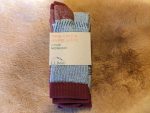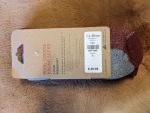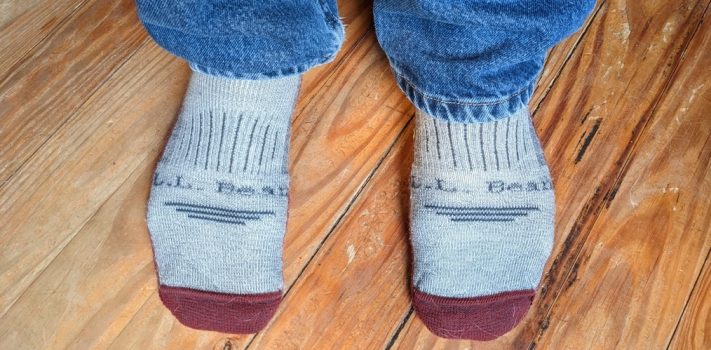Transportation is a wonderful thing. Whether flying a jet aircraft or bumping along in an oxcart on a dirt trail, it is great when someone or something else is expending the energy to carry us and our stuff where we want to go.
There are some times and some places where transportation is just not available. At those times and in those places, we are dependent upon our own two feet. In those types of situations, good boots and good socks may be the difference between getting where we need to go and not getting anywhere at all. Foot problems like blisters or frostbite can immobilize the hiker, leaving them vulnerable to hypothermia, sun stroke, dehydration, starvation, and other external threats.
I recently tested a couple of pairs of L.L. Bean wool Cresta hiking socks. I found them to be pretty good socks, although even better socks are available for a similar price. At the time of this writing, the Cresta socks cost $24.95 a pair at www.llbean.com. Darn Tough or Smartwool offer slightly better socks at a similar price. If you can get the L.L. Bean socks on sale or second-hand, they are good enough to be worth the investment. If you need to pay full price, the buy Darn Tough or Smartwool socks instead.
The Background
 My wife recently found a two pack of brand new L.L. Bean wool Cresta hiking socks at a thrift store. They were still in the original packaging, which was marked with the original price tag of $29.95 for the two-pair-pack. The thrift store had priced the two-pair-pack at $5.00, and it was then further marked down to 50% off. So we were able to buy the socks for a total cost of $1.25 a pair rather than the $24.95 a pair that they currently run at the L.L. Bean website. I was pretty happy to get them for 1/20th of the regular price.
My wife recently found a two pack of brand new L.L. Bean wool Cresta hiking socks at a thrift store. They were still in the original packaging, which was marked with the original price tag of $29.95 for the two-pair-pack. The thrift store had priced the two-pair-pack at $5.00, and it was then further marked down to 50% off. So we were able to buy the socks for a total cost of $1.25 a pair rather than the $24.95 a pair that they currently run at the L.L. Bean website. I was pretty happy to get them for 1/20th of the regular price.
First Impressions
The socks were packaged in a simple paperboard sleeve. That seemed like an appropriate packaging solution. The sleeve provided a surface for publishing helpful information about the product without diverting significant resources from the product itself.
The sleeve labeled the socks as “midweight.” That description seems about right. They are definitely not heavyweight socks, but are not quite as thin as lightweight socks either.
The socks are made of 78% Merino wool, 20% stretch nylon, and 2% LYCRA spandex. This blend is roughly similar to the blends used by a number of other high-quality Merino wool socks.
 The sleeve also announced that the socks are “Made in USA of imported yarn.” The description of the socks at www.llbean.com identifies a number of qualities of Merino wool which make that wool ideal for use in socks. These qualities include being itch-free, moisture-wicking, and odor-resistant. Two other good qualities of Merino wool that L.L. Bean forgot to mention are wear-resistance and flame-resistance.
The sleeve also announced that the socks are “Made in USA of imported yarn.” The description of the socks at www.llbean.com identifies a number of qualities of Merino wool which make that wool ideal for use in socks. These qualities include being itch-free, moisture-wicking, and odor-resistant. Two other good qualities of Merino wool that L.L. Bean forgot to mention are wear-resistance and flame-resistance.
Initial Testing
Under field conditions, it is sometimes necessary to wear socks for an extended period of time. In order to reflect these conditions in my testing, I wore a pair of the Cresta hiking socks every day for five days. Many of the good qualities of Merino wool were reflected throughout this initial testing period. The socks seemed to do a good job of wicking moisture away from my feet. They seemed to be durable, showing no signs of wear. They were odor-resistant, developing no noticeable scent during the course of the testing.
The only significant problem with the socks was that they were not itch-free. They weren’t bad at all for the first couple days of testing, but by the third day, there were noticeable signs of discomfort around my ankles, and by the fifth day of testing I was eager to take them off. They ended up being the itchiest pair of Merino wool socks that I have ever worn.
I repeated the testing with the second pair of socks. Once again, they were fine for the first couple of days, but by the third day they began to get uncomfortable. At the end of the third day I threw them in the laundry basket and put on a generic pair of Merino wool socks. The generic socks were much more comfortable.
Factors Influencing Itchiness
I had never had problems with itchiness with any of the other pairs of Merino wool socks that I have owned. I wondered if the L.L. Bean socks utilized a lower grade of Merino wool than my other Merino wool socks, or if L.L. Bean’s yarn supplier had slipped some lesser quality wool in with the Merino in order to boost their profit margin. As I studied the matter further, I discovered that there were a number of factors that might make the L.L. Bean socks itchier than my other Merino wool socks.
One factor is the environment in which the sheep are raised. In general, the healthier the environment, the less likely the wool will be itchy. It is possible that the sheep that provided the wool for the L.L. Bean socks were raised in a less healthy environment than the sheep that provided the wool for my other Merino wool socks.
A second factor is the thickness of the fibers. Merino wool comes in five grades ranging from “broad” to “ultra-fine”. In general, the thinner the fibers, the less itchy the fabric. The L.L. Bean socks might utilize wool with thicker or shorter fibers than my other Merino wool socks.
A third factor is processing. Some forms of processing break fibers, resulting in wool that it itchier than others. The wool used in the L.L. Bean socks might have been processed in harsher chemicals than my other Merino wool socks.
The most likely factor was newness. Newer fabric is often itchier than fabric that has been washed several times. I was not previously aware of this factor, but it helps to explain why I have had such wonderful results with used Merino wool socks purchased in thrift stores. They have already been washed several times, so they are even less itchy than brand-new Merino wool socks.
Further Testing
With this last factor in mind, I tested the socks again after they had been washed, wearing them every day for four days in a row. They were no longer itchy. I was happy to learn that good socks, like good cheese, may improve with age.
On the fourth day of testing, I needed to move some wood from one of my round wood stacks to the wood shed. Freezing rain was falling outside. I try not to let the weather interfere with my outside work too much for two reasons. One reason is that I have a limited amount of time to do my outside work, so I need to take advantage of every opportunity to get it done. The second reason is that working outside in inclement weather helps me to better evaluate the suitability of my outerwear for field conditions. If something doesn’t keep me comfortable working around the yard, I don’t want to find myself dependent upon it out in the field.
So I went out to move wood in spite of the nasty weather. Freezing rain was pelting off my jacket, and my boots were slogging through slush. But inside my boots, my feet were warm and comfortable inside the Cresta wool socks. Even when the boots started to leak a little, the socks still kept my feet warm. By the way, finding out that the boots leaked was a good example of evaluating the suitability of my outerwear. Those boots had never leaked before. Now I know that I should not continue to wear them under field conditions.
In addition to washing, another popular tip for making an itchy woolen item less itchy is to soak it in vinegar for half an hour, squeeze out the vinegar, and then lay the woolen item out to air dry. If the L.L. Bean socks had not responded so well to washing, that is what I would have tried next.
Based on my experience with Darn Tough Wool Socks, I consider them superior to the L.L. Bean socks that I tested. Even when my Darn Tough Wool Socks were brand new, I never noticed any itchiness. The lifetime warranty on the Darn Tough Wool Socks is better than the current warranty on the L.L. Bean socks as well.
Merino Wool
Merino wool is grown by Merino sheep. It is thinner and softer than regular wool, making it more comfortable next to the skin. The Merino breed of sheep was first developed in Spain during the 15th century. It became so sought after, that for a couple of centuries it was a capital crime to export the sheep from Spain. Beginning in the 18th century, the King of Spain began sending Merino sheep as gifts to other countries. There are now significant flocks in locations as scattered as France, Australia, the United States, South Africa, and Sweden.
Each Merino sheep produces about five pounds of wool each year. The sheep are totally dependent upon human care, since the wool continues to grow whether or not the sheep are shorn. An unshorn sheep can become immobilized and even blinded by excess wool growth if neglected for too long.
L.L. Bean History
L.L. Bean was founded by hunter and fisherman Leon Leonwood Bean in 1912 in Freeport, Maine. Initially the company was mail order only, selling just one product, the Maine Hunting Boot. L.L. Bean has gradually expanded their product line to include a host of other outdoor equipment and clothing. Some items in their product line have become more popular for their role as fashion statements rather than for their use in practical outdoor settings. I personally ascribe to the Patrick F. McManus school of low fashion, as brilliantly expounded in his short story, “The Outfit”. (Patrick F. McManus, “The Outfit” in A Fine and Pleasant Misery, New York: Holt, Rinehart and Winston, 1968-1978.)
Conclusion
L.L. Bean wool Cresta hiking socks are very good socks, but even better socks are available at similar prices. For example, the Darn Tough Men’s Hiker Micro Crew sock is very similar to the L.L. Bean Wool Cresta Hiking sock. At $25 a pair at Darntough.com at the time of this writing, the Micro Darn Tough sock costs about the same as the L.L. Bean sock as well. The Darn Tough sock is composed of 61% Merino wool, 36% nylon, and 3% Lycra spandex. I have never had problems with any of my Darn Tough socks itching, not even the ones that I purchased brand new.
If you can get the L.L. Bean socks inexpensively at a thrift store, I would recommend buying them. You can expect good service from them after one or more washings. But if you are going to pay full price, I would recommend getting another brand of Merino wool or Alpaca socks instead.
Disclaimer
I did not receive any financial or other inducement to mention any vendor, product, or service in this article.










